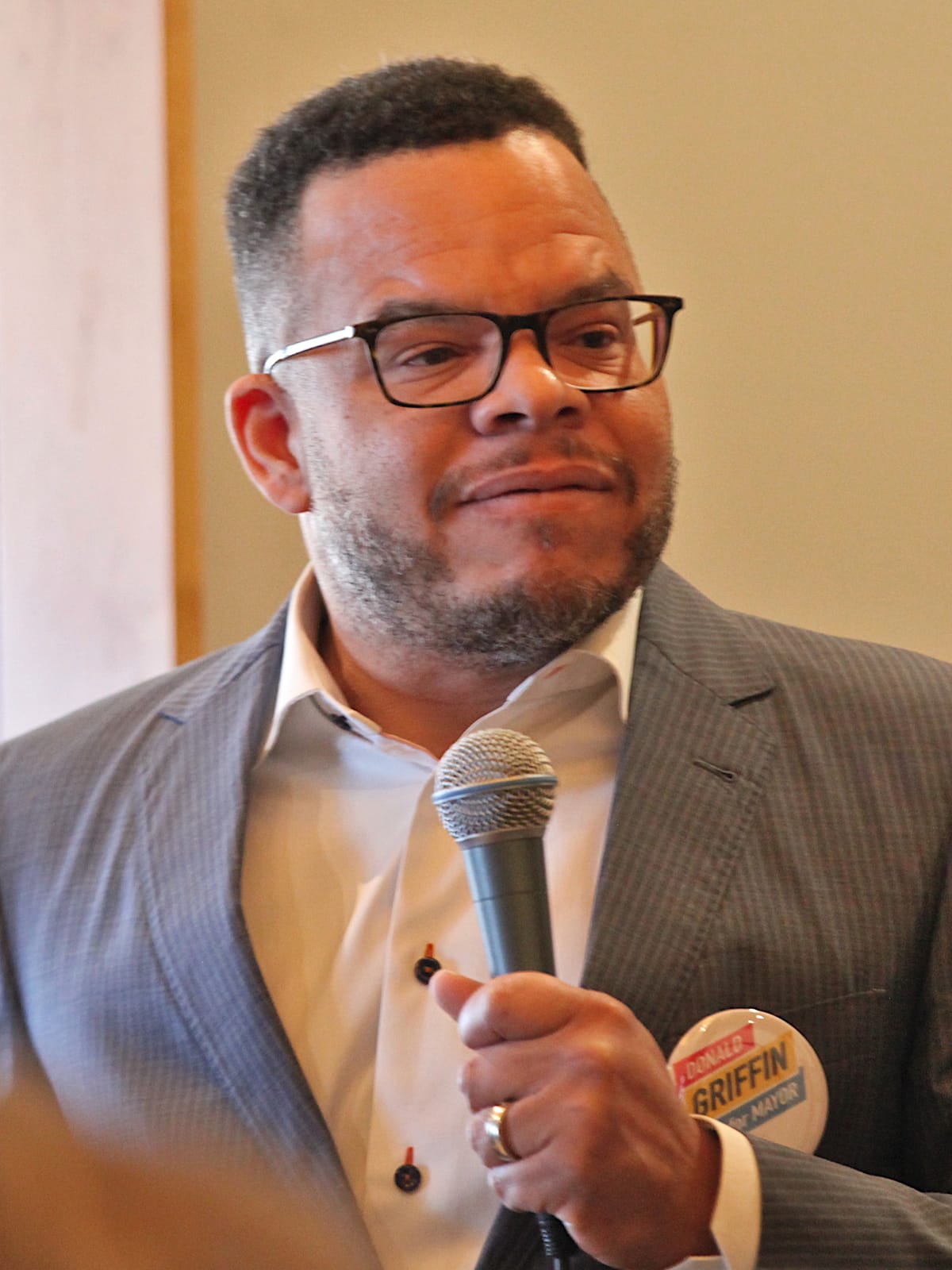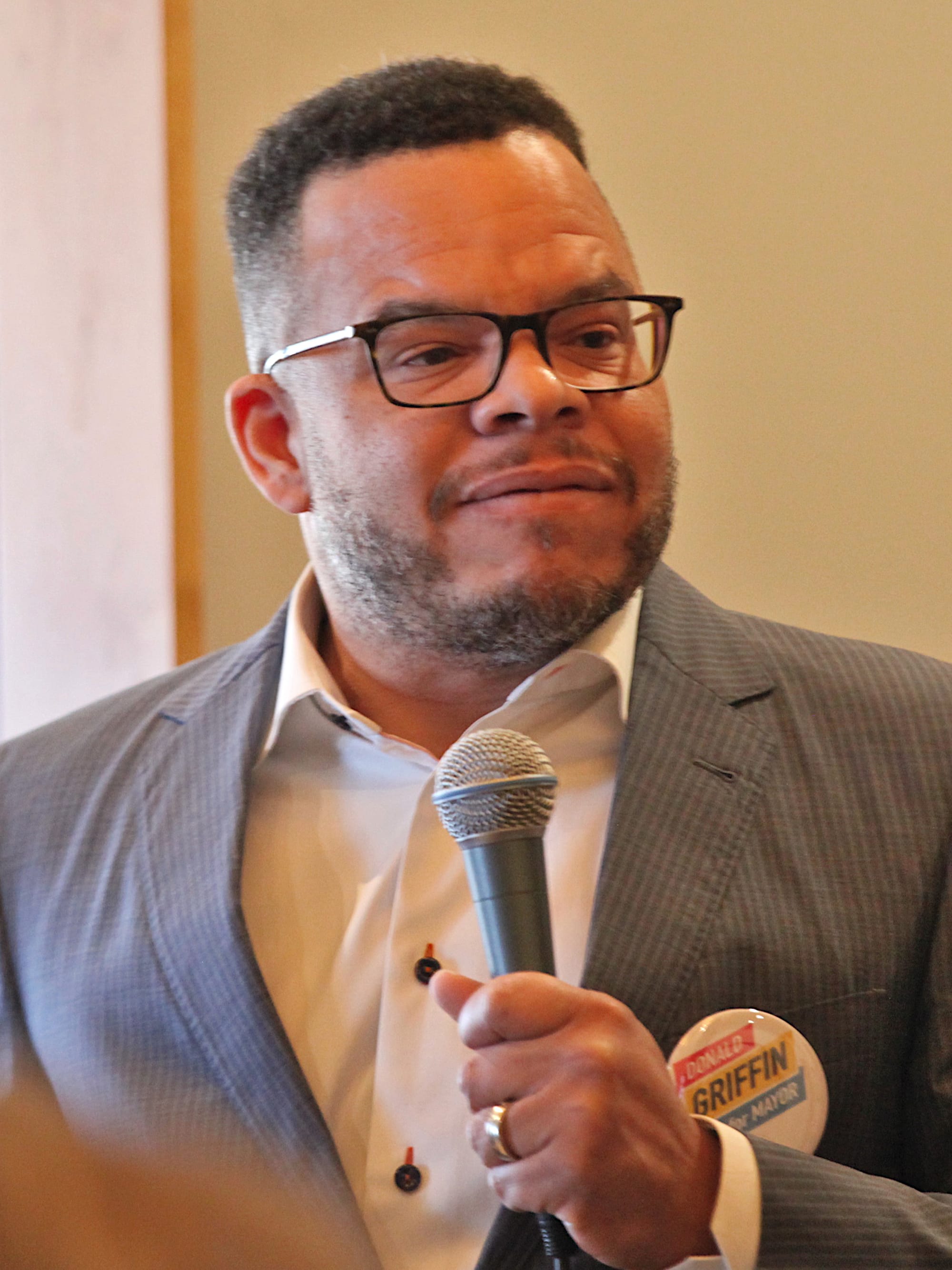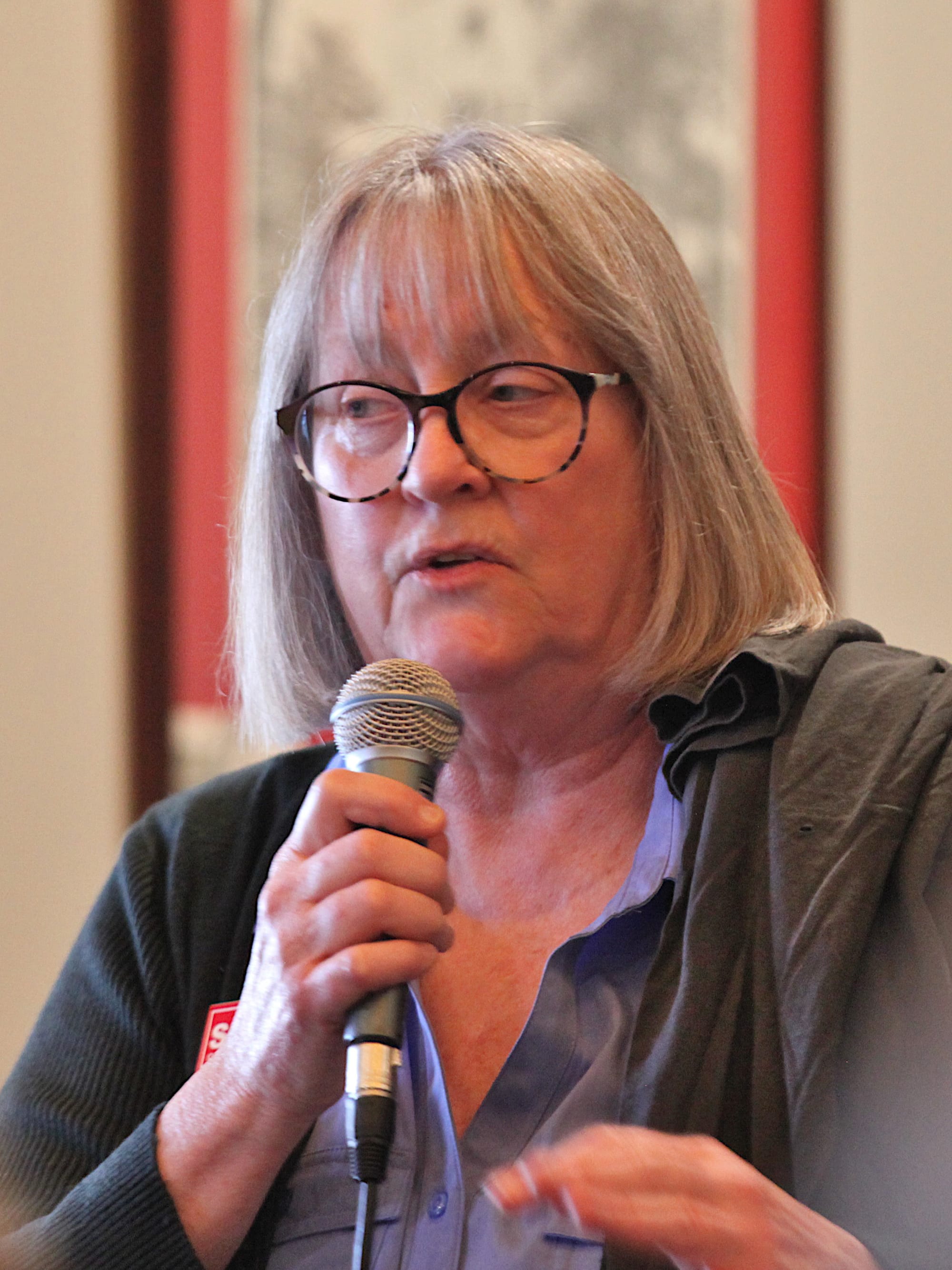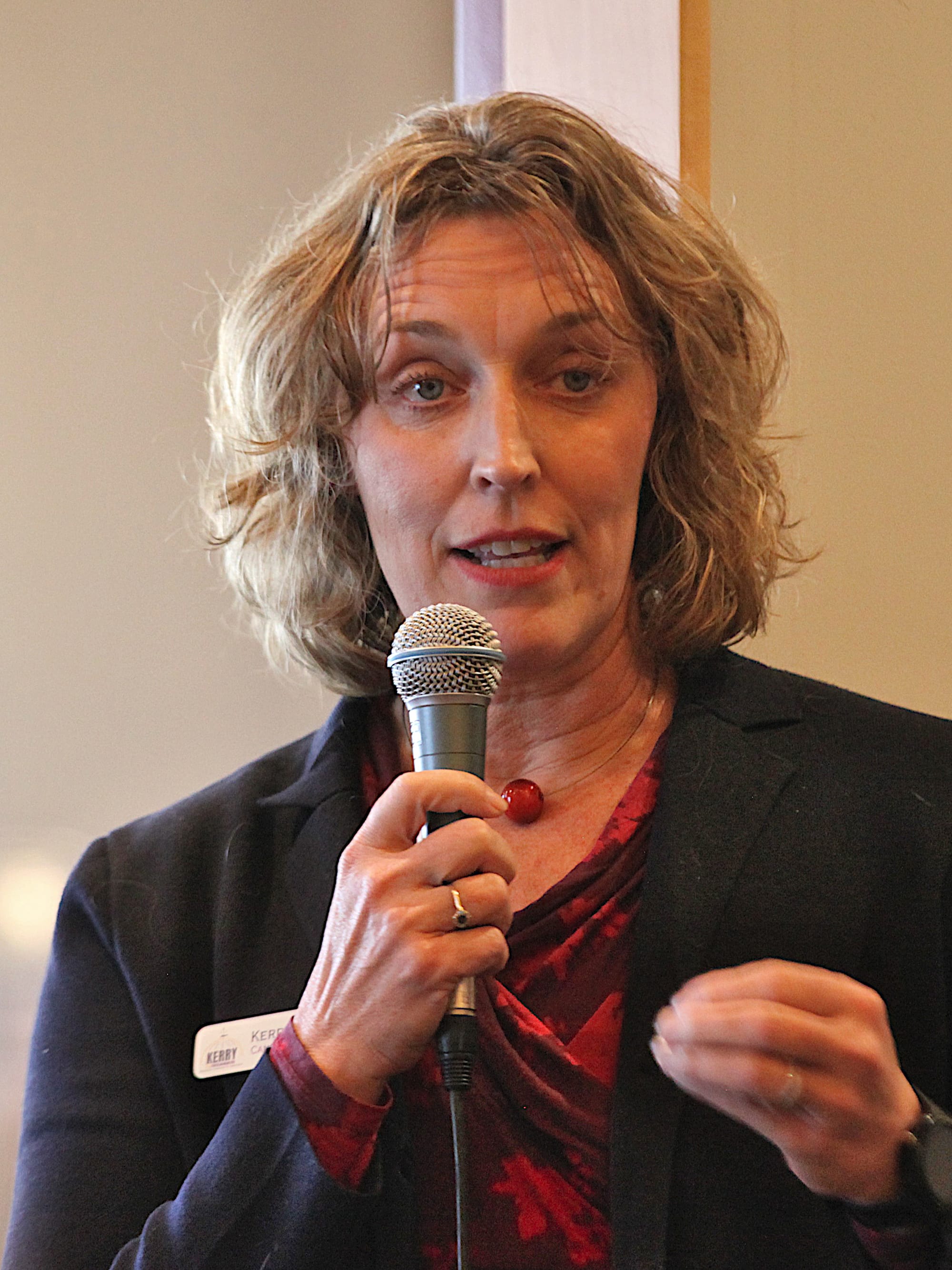3 Bloomington mayoral hopefuls speak at first forum




Appearing in the same room at the same time on Tuesday were all three Bloomington mayoral candidates in the May 2 primary race for the Democratic Party’s nomination: Don Griffin, Susan Sandberg, and Kerry Thomson
The room was Aver’s Public House on South College Mall Road. The occasion was a regular meeting of the Monroe County Democrats’ Club. Each candidate delivered a stump speech. After that, they fielded a few questions as a group.
Also given time to speak was the sole candidate for city clerk, incumbent Nicole Bolden, as well as the two candidates for the District 2 city council seat, Kate Rosenbarger and Sue Sgambelluri, who both currently serve on the city council. The outcome of the redistricting process put the two in the same district.
This report from the Feb. 21 event is confined to the remarks and the Q&A for the mayoral candidates.
The stump speeches from mayoral candidates offered no real surprises, and tracked with the remarks given by each candidate at their respective campaign launch parties.
Questions from attendees included a range of topics. Answers to two of them are reported out in detail below—one on transportation options and another on growth.
The report below is organized chronologically.
Susan Sandberg: Stump speech
Sandberg led off by talking about what several attendees had in common—she thanked those in attendance who were currently serving as elected officials, or had served in the past, or who are currently running for office.
That’s a group that in addition to Sandberg, included other current councilmembers: Kate Rosenbarger, Sue Sgambelluri, Ron Smith, Isabel Piedmont-Smith, Steve Volan, and Jim Sims. Former city councilmembers Timothy Mayer and David Sabbagh also attended.
In addition to the current city clerk Nicole Bolden, former city clerk Regina Moore attended, as did current mayor John Hamilton, who is not seeking re-election. Current county commissioner Penny Githens was there, as was Vi Simpson, who previously served as a state senator and county auditor. County councilor Cheryl Munson was also there.
Jenny Stevens, one of two candidates for the District 5 city council seat was there. The other District 5 candidate is Shruti Rana.
Sandberg then talked about shared attitudes: “I know the one thing we all share in common—we love this city. And we want to keep it moving forward in a healthy and strong direction.”
Before ticking through the four planks of her platform, Sandberg gave her general take on growth: “I want a Bloomington that is better, not necessarily bigger.”
Then came the platform: affordability; public safety and public health; better collaboration with city partners and county colleagues; and essential city services.
Sandberg introduced the final point of her platform by describing herself as a “pro-labor Democrat.” She added, “We need to make sure that…we’re taking good care of our employees who keep the wheels turning, and that we are paying attention to our infrastructure, our streets, sidewalks, sanitation facilities.”
Sandberg traced her involvement in politics to the Vote Run Lead organization, and held up a T-shirt from that era. “I’ve been in the pipeline for many, many years,” she said.
She described her first run for city council for the District 2 seat against two-term incumbent, Republican Jason Banach. She lost that race after being put on the ballot by then county party chair Frank McCloskey—she had not declared herself a candidate in the Democratic Party’s primary.
“When you run and you don’t win, it’s a very humbling experience,” Sandberg said. She added, “But it’s a learning experience.” Even though she lost that election, she “did keep at it” by accepting an appointment on Bloomington’s utilities service board.
Sandberg said she started paying closer attention to what other councilmembers were doing. When at-large councilmember Chris Gaal was elected as county prosecutor, that created a vacancy on the city council. In 2007 Sandberg was caucused into Gaal’s seat.
“This is my 17th year on the council—I know where things are in city hall,” Sandberg said. The line drew a chuckle from some in the audience.
Sandberg started the wind-up to her remarks by hitting some of her platform points again, saying there would be time later to talk about details. Her platform point of affordability includes not just housing affordability, but also wages, she said.
Public safety includes more than just law enforcement, Sandberg said. Collaboration is essential, Sandberg said, “in order for us to do better work, in a more communicative, more collegial, more civil and more respectful manner.”
Sandberg kicked out of her remarks with a description of her leadership style: “I am going to be a bottom-up leader not a top-down leader,” she said. She continued, “I’m used to playing in ensembles. And so that’s the way things will roll with the Sandberg administration.”
The allusion to “ensembles” was to her ukulele band, The UkeTones, which played her campaign kickoff party.
Don Griffin: Stump speech
Griffin led off his Tuesday remarks by establishing his hometown bona fides: “Fifty-two years of my life, I’ve been in Bloomington. Love it. Will always love it.”
He added, “And I’ll be here for the next 50 years.”
Next came the catchphrase that he announced at his campaign kickoff party: “Believe in Bloomington.”
Griffin elaborated on the catchphrase: “Who we need to be is who we actually are—but just better. We need to lean into who we are. By believing in Bloomington, we can boldly become Bloomington.”
Growth while preserving small-town charm was a theme that Griffin weaved through his stump speech as well as his answers to questions.
In his stump speech, he started a sentence with a general statement: “I think that we can be one of the best communities in the entire country…” then revised that to add one adjective: “…one of the best small communities in the entire country.”
Then came the elements of Griffin’s platform: sustainability; diversity and inclusion; housing; and job creation and attraction. At the core of Bloomington’s growth must be sustainability, Griffin said, as the city faces the climate crisis with policies that consider social, environmental, and economic impact and build resilience.
Griffin said Bloomington should be a leader on response to climate change, not just in the state of Indiana, but in the entire country
About diversity, equity, inclusion and accessibility, Griffin said, “We’re now in an era in which everyone can belong.” Griffin pointed to differences among us as something to be highlighted, from which the community can draw strength: “I think Bloomington is stuck in the era of where we don’t see our differences.”
Griffin continued, “But the new era is where we say: Look at our differences, and celebrate them.” He added, “If we do that, as Bloomingtonians, we’ll be celebrating every day of the week.”
“We want our children, no matter who they love, no matter what color they are, no matter who they serve, to be celebrated. And loved,” Griffin said.
Griffin is founder and owner of Griffin Realty. About housing, Griffin said he’s been in the business for 32 years. “I know housing,” he said.
He stressed the need to set goals and take steps to meet them. Given that only 38 percent of Bloomington residents own their own home, Griffin said his goal is to reach 50 percent home ownership, within four to six years.
To reach that 50-percent goal, Griffin said, “I know how to do it—we’ve got the people in place at city hall already ready to go.” At the same time, Griffin said, “We also have to protect our core neighborhoods.”
Griffin sees significant growth as inevitable: “Bloomington is growing, folks—the idea of us remaining a small, sleepy town is over.” Bloomington pointed to the not-yet-completed I-69 as a factor that will fuel future Bloomington growth. When I-69 is completed, Griffin said, from the center of Indianapolis, it will be easier to get to Bloomington than to Carmel.
“We can keep it quaint, it can still be beautiful, Griffin said.”
Economic and cultural growth will require figuring out ways to retain the students and graduate workers that are here, Griffin said. People who are between 23 and 33 years old don’t have a lot to do in Bloomington, Griffin said. A line about that age group that got its intended laugh from the audience: “I am calling that the lonely decade.”
“Bloomington is a wonderful place to live—if you’re retired,” Griffin said. That’s not necessarily true for 23-to-33-year-olds, he added. On the notion of so-called “Bloomerangs”—people who leave but return to Bloomington, Griffin said, “We have to ask ourselves, why do people have to leave?”
Griffin’s answer: “It’s a lack of jobs.” He added, “And honestly, it’s actually lack of play. We have to create opportunities for them to do things after work.”
Griffin pointed to the Indiana University Jacobs School of Music and Eskenazi Museum of Art as institutions that help make Bloomington a cultural destination. But Bloomington has not always approached the idea of creating a cultural designation in a strategic way, Griffin said. “We need to use our resources to become the arts and music and cultural destination of the Midwest,” he said.
Griffin bookended his stump speech with an allusion to his catch phrase: “I’m not talking about doing anything different than who we are—just being better at it—being the best at being Bloomington, being boldly Bloomington.”
Kerry Thomson: Stump speech
Thomson led off with a standard question: Why are you running for mayor? Thomson’s answer: “We simply need to do things differently. What we’re doing is not working.”
Key to making things work better, Thomson said, is to “bring people back to the table.” Later in her stump speech, she returned to that theme by saying, “If the table at city hall is not working, take the table out to the people—find ways to listen that are new.”
“Bloomington is an incredible city. And it deserves an incredible city government,” Thomson said. Employees as well as residents need to be looped into the mix, she said: “We have people who work hard to serve this city. And we also have residents who want to have a say in how we are envisioning our way forward.”
Thomson then turned to her own background, which includes 20 years as CEO of Habitat for Humanity. But her work for that organization stretches back longer than that, to include a total of 32 years of experience with Habitat. That matches the time that Griffin has been working in the housing sector, she said.
For the last five years, Thomson has served as director for the Center for Rural Engagement at Indiana University. A fact that drew a murmur from the crowd: CRE works with 70 different municipalities. Thomson said that CRE works to improve health, community resilience and quality of place.
In the five years since CRE was created, more than 30,000 leaders had been looped into the center’s work. “That is a lot of voices at the table,” Thomson said. She added, “It’s a lot of gathering people and asking them what they envision for their community and helping them weave together plans that actually work for their communities.”
Thomson recounted how she came to live in Bloomington. She was riding her bicycle from San Francisco to Washington, D.C. and stopped over in Bloomington for about 36 hours. “By the time I cycled out of town, I told my buddy: I’m going to move back here.”
About Bloomington, Thomson said, “This is a place that calls to me.” She elaborated, “I saw people gathered on sidewalks, engaged in lively conversations. I sensed the vibrant arts and culture that we have here. Since moving to Bloomington, Thomson said she’s been able to articulate more clearly what it is about Bloomington that calls to her: “It’s a community that really beckons true belonging, true community. And that is the Bloomington that I would like to help create.”
Thomson then turned to the kind of problems she wants to solve. “We are a great city. But we have allowed problems to reach crisis level.” She named a couple of issues she’s heard people talk about during her listening sessions over the last seven months: “Why is our population of people who are unhoused… growing, when we keep putting efforts behind assisting? Why are housing prices skyrocketing?”
When it tries to address problems like that, Bloomington’s government right now “does not work in partnership,” Thomson said.
About the legislative side, Thomson said, “We have a divided city council.” About the executive side, she said, “We have heard proposals that are really plans, before they get any community input.”
What Bloomington deserves from its government is true collaboration, Thomson said. Over the course of her career, she’s worked “on the ground, to build coalitions to listen to people to work side by side with them.” She added, “And that is what I’ll continue to do as your mayor.”
Thomson listed out three priorities as mayor, based on what she’s heard during her listening sessions. The first is “how we do government.” Thomson said that means bringing people to the table to: “let them help co-create the solutions that work.”
Thomson’s second priority is “attainable” housing. “That does not mean megaplex apartments all over our city,” she said.
Thomson’s third priority is “solving the challenges…with public safety especially as it pertains to the mental health and substance use crisis that we are currently experiencing downtown.”
About Bloomington’s unhoused residents, Thomson said, “The people living in tents deserve a life of dignity. And there is no dignity right now in how we’re moving them place to place.”
Thomson said Bloomington stands at a crucial moment in time: “I would say that Bloomington is also at a crossroads of our history.” She added, “I think, and I suspect that you agree, that the next four years are going to define what Bloomington looks like for the next 40 years.”
The solutions that work for Bloomington over the next four decades will not be “cookie cutters from somewhere else, but instead are unique, wonderful Bloomington solutions,” she said. Thomson wrapped up by saying, “We can solve these challenges, but we must work together.”
Questions and Answers
Q&A: Transportation options
Among the questions fielded by candidates was one from former city councilmember David Sabbagh, who served on the city council from 1996 to 2007, which means he overlapped with two current councilmembers, Susan Sandberg and Steve Volan.
Sabbagh phrased his question like this: “It seems to be that everyone wants to make sure that the students have lots of bike paths and stuff. What about those of us who drive safely and want safety? What are you going to do for us and help us get downtown?”
Griffin was first with the mic. “The future of Bloomington lies in being a great multi-generational community,” he said. Diversity, inclusion, and accessibility is important, he told Sabbagh. “So as we look to the future, we also need to look to the people—I’m not saying you’re the past, believe me—we all have to work together!” That got a laugh from Sabbagh.
Griffin continued, “Let’s be honest, people are living longer—I told you, I’m gonna be here for another 50 years.” He wrapped up by saying, “I want to be a community that’s great for me and great for my son.” Sabbagh’s point, Griffin said, was duly noted.
Next up was Thomson. “I think multimodal transit is key, and I ride my bike to work pretty much every day.” She recounted how she had recently had to wear a support boot for her injured ankle. “We need to be thinking about not only how to make things safe for cyclists, but also for pedestrians,” Thomson said.
Some of the cycling infrastructure unintentionally makes things a little bit more difficult for a pedestrian sometimes, Thomson said. Downtown should be accessible for people who can’t walk a great distance, she said.
When Kirkwood Avenue is closed in the summer, Thomson reported that the location for her bus stop, where she gets off for work, gets changed so that the distance from the bus stop to her job increases from two blocks to six blocks. Thomson summed up by saying there are solutions to these challenges: “We can have bikes, and pedestrians, and cars.”
Sandberg named a specific infrastructure project that she thinks “is not working well for everyone in the community,” based on what she’s heard knocking on doors—the 7-Line separated bicycle lane. “We may need to take another look at that, and see if we can redesign it in a way to make it safe for not only the bicyclists” but for other road users. What she hears is that the 7-Line is “rough for buses, it’s rough for emergency vehicles, it doesn’t feel safe for pedestrians trying to get across.”
Sandberg took the chance to highlight how the 7-Line impacts the workers who provide basic city services. To tip the trash carts for houses on the bike lane side of the street, the city’s sanitation workers have to drag the carts across the lane separation, Sandberg said.
The city should build infrastructure that is considerate of all users of streets, Sandberg said. People won’t visit downtown, if they can’t find a place to park, so that they can take advantage of the amenities of the downtown. “We can do better,” Sandberg said. “This is what I mean by building a better Bloomington, not necessarily a bigger one.”
Q&A: Growth
Former city clerk Regina Moore asked about growth. “What is your idea of growth? What’s enough? When will we know that we’ve grown enough?”
Thomson had first crack at Moore’s question. Thomson said she had not talked about “growth” but rather about “attainable housing.” Thomson continued, “We’re at a point where we really need to carefully study how much we grow. And how much is enough for Bloomington.” She added, “I don’t know that anybody has that data yet.”
Thomson noted that there are a lot of people who work in Bloomington who work here, but are unable to live in Bloomington. That is a group that should have a place in Bloomington to live. Thomson thinks there’s a risk of having “Soviet-era apartment complexes everywhere” if Bloomington doesn’t have a clear plan for “what we want, what that looks like, and importantly, how our community feels.” For Thomson, the right question to ask is: “How do we develop in a way that feels like the Bloomington that we want to be today, and in 40 years?”
Griffin started his answer by saying, “You know, I’m not trying to be negative or argumentative, but I don’t know how to stop growth.” Griffin continued, “I don’t think we have the ability to say who gets to come and who doesn’t get to come. It’s happening.” He added, “Bloomington continues to grow 1,200 to 1,500 people a year.”
Griffin noted that people move to Ellettsville or Spencer or Greene County, because there’s not enough housing in Bloomington. “We’re talking about smart, educated people and job creators moving outside of our community,” Griffin said.
Griffin compared Bloomington’s size to that of Ann Arbor, Michigan, home to the University of Michigan. “It’s bigger than us by 50,000 to 80,000 people,” Griffin said. “I don’t think anyone who’s been to Ann Arbor says that it’s not a quaint or a neat town,” Griffin said.
Griffin said Bloomington needs to get ready for the eventual completion of I-69: “We need to be prepared.” He repeated a point from his stump speech: When I-69 is completed, getting from Indianapolis to Bloomington will be faster than getting from Indianapolis to Carmel. “I think most people would much rather live in Bloomington, than the Disney World version of Bloomington,” Griffin said.
Housing prices will continue to rise, Griffin said. He concluded, “There are creative solutions, and we’ve got a lot of creative people that can make that happen.”
Sandberg responded to Moore’s question about growth by saying, “I agree that Bloomington is a really great place. And a lot of people really are attracted to come here, because of the amenities, the cultural attractions, the university, all the things that we can boast of, for a small second class city.”
The designation of “second class” city is defined under state law by population—all cities except for Indianapolis are second or third class cities.
What worries Sandberg is not that more people are coming to Bloomington, but that some who live here now are leaving. “I’m hearing a lot of people who are leaving Bloomington because they are not happy with the quality of life,” she said.
Sandberg continued, “We’re starting to lose that charm, we’re starting to lose that character of our neighborhoods and our downtown attractions, that human scale of housing that I think we would all prefer to see.”
Sandberg also pointed to the relationship between growth and infrastructure. “That costs every time you grow—you’re gonna have to expand your infrastructure.” Sandberg also talked about growth from the angle of the expanded geography of the city through annexation. “We have to be able to look the people in the eye, who we are annexing, and tell them: You’re going to get great services from our police department and our fire department and our emergency responders and our utilities and our sanitation.”
She reminded the audience that she was one of three councilmembers who had voted against annexation. The other two were Dave Rollo and Ron Smith. As mayor, Sandberg said, “I’m going to take a really hard look at that, because we must be mindful and responsible in the way we grow.”




Comments ()